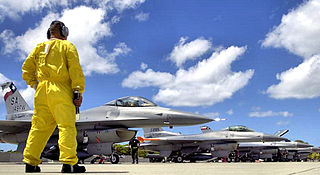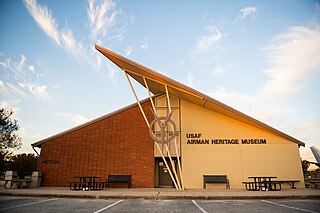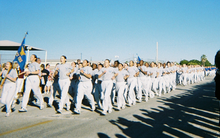
Tyndall Air Force Base is a United States Air Force Base located 12 miles (19 km) east of Panama City, Florida. The base was named in honor of World War I pilot 1st Lt. Frank Benjamin Tyndall. The base operating unit and host wing is the 325th Fighter Wing of the Air Combat Command (ACC). The base hosts 2,902 active duty members. In October 2018, Hurricane Michael caused significant damage to the base.

The Second Air Force is a USAF numbered air force responsible for conducting basic military and technical training for Air Force enlisted members and non-flying officers. In World War II the CONUS unit defended the Northwestern United States and Upper Great Plains regions and during the Cold War, was Strategic Air Command unit with strategic bombers and missiles. Elements of Second Air Force engaged in combat operations during the Korean War; Vietnam War, as well as Operation Desert Storm.

The Sixteenth Air Force (Air Forces Cyber) (16 AF) is a United States Air Force (USAF) organization responsible for information warfare, which encompasses intelligence gathering and analysis, surveillance, reconnaissance, cyber warfare and electronic warfare operations. Its headquarters is at Joint Base San Antonio-Lackland in Texas.

The Texas Air National Guard (TX ANG) is the aerial militia of the State of Texas, United States of America. It is, along with the Texas Army National Guard, an element of the Texas National Guard. No element of the Texas Air National Guard is under United States Air Force command. They are under the jurisdiction of the Governor of Texas through the office of the Texas Adjutant General unless they are federalized by order of the President of the United States. The Texas Air National Guard is headquartered at Camp Mabry, Austin, and its chief of staff is Brigadier General Matthew Barker.

The Air Education and Training Command (AETC) is one of the nine Major Commands (MAJCOM) of the United States Air Force (USAF), reporting to Headquarters, United States Air Force. It was established 1 July 1993, with the realignment of Air Training Command and Air University.

The Air Force Materiel Command (AFMC) is a Major Command (MAJCOM) of the United States Air Force (USAF). AFMC was created on July 1, 1992, through the amalgamation of the former Air Force Logistics Command (AFLC) and the former Air Force Systems Command (AFSC).

Mather Air Force Base was a United States Air Force Base, which was closed in 1993 pursuant to a post-Cold War BRAC decision. It was located 12 miles (19 km) east of Sacramento, on the south side of U.S. Route 50 in Sacramento County, California. Mather Field was one of 32 Air Service training camps established after the United States entry into World War I in April 1917.

Kelly Field is a Joint-Use facility located in San Antonio, Texas. It was originally named after George E. M. Kelly, the first member of the U.S. military killed in the crash of an airplane he was piloting.

The Air Training Command (ATC) is a former United States Air Force (USAF) Major Command designation. It was headquartered at Randolph Air Force Base, Texas, but was initially formed at Barksdale Air Force Base, Louisiana. It was re-designated as Air Education and Training Command (AETC) following a merger with Air University (AU) on 1 July 1993.

The Western Air Defense Sector (WADS) is a unit of the Washington Air National Guard located at Joint Base Lewis-McChord, Tacoma, Washington.

The 37th Training Wing is a unit of the United States Air Force assigned to the 2nd Air Force and the Air Education and Training Command. As the host unit to Lackland Air Force Base, Joint Base San Antonio, Texas, the 37th TRW is the predominant unit on the installation and is the largest training wing in the USAF. Known as the "Gateway to the Air Force", the 37th Training Wing's replaced the Lackland Training Center as the single basic military training for the USAF.

The 59th Medical Wing (MDW) is the U.S. Air Force's largest medical wing and is the Air Force functional medical command for Joint Base San Antonio (JBSA). It comprises seven medical groups across San Antonio. Three are located at the Wilford Hall Ambulatory Surgical Center (WHASC); the 959th Medical Group is located at San Antonio Military Medical Center (SAMMC), JBSA-Fort Sam Houston; the 59th Training Group - the wing's newest group, activated on 4 January 2016, is also located at JBSA-Fort Sam Houston. The 359th and 559th Medical Groups are located at and support the missions of JBSA-Randolph and JBSA-Lackland, respectively.

The 149th Fighter Wing is a unit of the Texas Air National Guard, stationed at Kelly Field Annex, Joint Base San Antonio, Texas. If activated to federal service, the Wing is gained by the United States Air Force Air Education and Training Command.

Ellington Field Joint Reserve Base is a joint installation shared by various active component and reserve component military units, as well as aircraft flight operations of the National Aeronautics and Space Administration (NASA) under the aegis of the nearby Johnson Space Center. The host wing for the installation is the Texas Air National Guard's 147th Attack Wing. Opened in 1917, Ellington Field was one of thirty-two Air Service training camps established after the United States entry into World War I. It is named for First Lieutenant Eric Ellington, a U.S. Army aviator who was killed in a plane crash in San Diego, California in 1913.

Twenty-Fourth Air Force / Air Forces Cyber (AFCYBER) was a Numbered Air Force within the United States Air Force. The Air Force consolidated its cyberspace combat and support forces into 24 AF. 24 AF was the Air Force component of U.S. Cyber Command.

The 502d Air Base Wing is a United States Air Force unit that provides installation support for Joint Base San Antonio. The 502d activated on 1 August 2009. The wing's three Mission Support Groups perform the installation support mission at each major installation in the San Antonio area.

Joint Base San Antonio (JBSA) is a United States military facility located in San Antonio, Texas, US. The facility is under the jurisdiction of the United States Air Force 502d Air Base Wing, Air Education and Training Command (AETC). The wing's three Mission Support Groups perform the installation support mission at the three bases that form JBSA.

Perrin Air Force Station is a closed United States Air Force General Surveillance Radar station. It is located 1.3 miles (2.1 km) southeast of North Texas Regional Airport, Texas. It was closed in 1971.

A United States Air Force Tactical Air Control Party, commonly abbreviated TACP, is an individual or team of United States Air Force Special Warfare Airmen with AFSC 1Z3X1, who are aligned with conventional, Special Operation Forces, and Tier 1 combat maneuver units. They provide precision terminal attack control and terminal attack guidance of U.S. and coalition fixed- and rotary-wing close air support aircraft, artillery, and naval gunfire; establish and maintain command and control (C2) communications; and advise ground commanders on the best use of air power.

The USAF Airman Heritage Museum is an aviation field museum and heritage collection of the United States Air Force located at Lackland AFB near San Antonio, Texas. The museum, along with the Security Forces Exhibit Annex, are part of the Airman Heritage Training Complex, run by the Air Education and Training Command. Its mission is to preserve and honor the history and heritage of enlisted airmen.






























